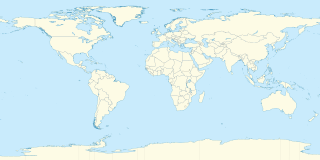 W
WThis is a list of earthquakes in 2011. Only earthquakes of magnitude 6 or above are included, unless they result in damage and/or casualties, or are notable for some other reason. All dates are listed according to UTC time. The 9.1 Tōhoku earthquake was the fourth most powerful ever recorded and triggered a massive tsunami. In a very busy year, many quakes caused damage in Turkey, New Zealand, Myanmar, India, or Spain.
 W
WThe 2011 Burma earthquake occurred with a magnitude 6.9 Mw on 24 March. It had an epicenter in the eastern part of Shan State in Burma (Myanmar) with a hypocenter 10 km deep. It had two aftershocks, one of magnitude 4.8, another at magnitude 5.4, and two subsequent shocks at magnitude 5.0 and 6.2. The quake's epicentre was 70 miles (110 km) from the northern Thai city of Chiang Rai, north of Mae Sai and southeast of Kentung.
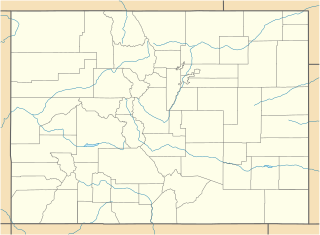 W
WThe 2011 Colorado earthquake occurred on August 22 at 11:46 PM MDT with a moment magnitude of 5.3 and a maximum Mercalli intensity of V (Moderate). The epicenter of the intraplate earthquake was 10 mi (20 km) west northwest of Trinidad, Colorado, and 180 mi (290 km) south of Denver, according to the United States Geological Survey (USGS). It was the largest natural earthquake to affect Colorado for more than a hundred years.
 W
WThe 2011 Dalbandin earthquake occurred on 19 January at 01:23 AM local time with a moment magnitude of Mw 7.2 and a maximum Mercalli intensity of VI (Strong). The shock occurred in a sparsely populated area of Balochistan, caused moderate damage, three deaths and some injuries.
 W
WThe 2011 Fergana Valley earthquake affected Uzbekistan, Kyrgyzstan and Tajikistan at 01:35 local time on 20 July. The dip-slip shock had a moment magnitude of 6.2 and a maximum Mercalli intensity of VIII (Severe). Its epicenter was located just inside Kyrgyzstan's border in the Fergana Valley region. Fourteen were killed and eighty-six were injured.
 W
WThe 2011 Guerrero earthquake struck with a moment magnitude of 5.7 in southern Mexico at 08:24 local time on 5 May. It was positioned west of Ometepec, Guerrero, with a focal depth of 24 km (14.9 mi), and was lightly felt in many adjacent areas.
 W
WThe 2011 Kütahya earthquake struck near a populous region of western Turkey at 23:15 EEST (20:15 UTC) on 19 May with a moment magnitude of 5.8 and a maximum Mercalli intensity of VII. With an epicenter just to the east of Simav, it occurred at an estimated depth of 9.1 kilometers (5.7 mi), resulting in strong shaking in much of Kütahya.
 W
WThe 2011 Oklahoma earthquake was a 5.7 magnitude intraplate earthquake which occurred near Prague, Oklahoma on November 5 at 10:53 p.m. CDT in the U.S. state of Oklahoma. The epicenter of the earthquake was in the vicinity of several active wastewater injection wells. According to the United States Geological Survey (USGS), it was the most powerful earthquake ever recorded in Oklahoma; this record was surpassed by the 2016 Oklahoma earthquake. The previous record was a 5.5 magnitude earthquake that struck near the town of El Reno in 1952. The quake's epicenter was approximately 44 miles (71 km) east-northeast of Oklahoma City, near the town of Sparks and was felt in the neighboring states of Texas, Arkansas, Kansas and Missouri and even as far away as Tennessee and Wisconsin. The quake followed several minor quakes earlier in the day, including a 4.7 magnitude foreshock. The quake had a maximum perceived intensity of VIII (Severe) on the Mercalli intensity scale in the area closest to the epicenter. Numerous aftershocks were detected after the main quake, with a few registering at 4.0 magnitude.
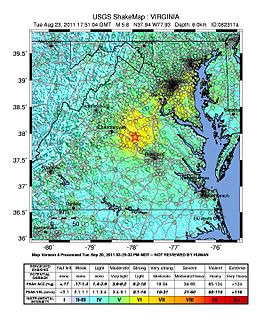 W
WOn August 23, 2011, a magnitude 5.8 earthquake hit the Piedmont region of the Commonwealth of Virginia, United States, at 1:51:04 p.m. EDT. The epicenter, in Louisa County, was 38 mi (61 km) northwest of Richmond and 5 mi (8 km) south-southwest of the town of Mineral. It was an intraplate earthquake with a maximum perceived intensity of VII on the Mercalli intensity scale. Several aftershocks, ranging up to 4.5 Mw in magnitude, occurred after the main tremor.
 W
WThe 2011 Zumpango earthquake occurred at 19:47 local time on 10 December with a moment magnitude of 6.5 and a maximum Mercalli intensity of VII. Its epicenter was located in the city Zumpango, Guerrero, roughly equidistant between the metropolitan areas of Mexico City and Acapulco. The quake was felt in Guerrero, Michoacán, Mexico State, Mexico City and Puebla.
 W
WThe April 2011 Fukushima earthquake was a potent magnitude 6.6 Mw intraplate aftershock that occurred at 17:16 JST (08:16 UTC) on 11 April, in the Hamadōri region of Fukushima, Japan. With a shallow focus of 13 km (8.1 mi), the earthquake was centred inland about 36 km (22 mi) west of Iwaki, causing widespread strong to locally severe shaking. It was one of many aftershocks to follow the 11 March Tōhoku earthquake, and the strongest to have its epicentre located inland.
 W
WThe April 2011 Miyagi earthquake occurred off the coast of Miyagi Prefecture, approximately 66 kilometres (41 mi) east of Sendai, Japan. The Mw7.1 thrust earthquake was classified as an aftershock of the March 11 Tōhoku earthquake, and occurred at 23:32 JST (14:32 UTC) on Thursday, 7 April 2011.
 W
WA Mw6.2 earthquake occurred in Christchurch on Tuesday 22 February 2011 at 12:51 p.m. local time. The earthquake struck the Canterbury region in New Zealand's South Island and was centred 6.7 kilometres (4.2 mi) south-east of the centre of Christchurch, New Zealand's second-most populous city. The earthquake caused widespread damage across Christchurch, killing 185 people in the nation's fifth-deadliest disaster.
 W
WThe June 2011 Christchurch earthquake was a shallow magnitude 6.0 Mw earthquake that occurred on 13 June 2011 at 14:20 NZST. It was centred at a depth of 7 km (4.3 mi), about 5 km (3 mi) south-east of Christchurch, which had previously been devastated by a magnitude 6.2 MW earthquake in February 2011. The June quake was preceded by a magnitude 5.9 ML tremor that struck the region at a slightly deeper 8.9 km (5.5 mi). The United States Geological Survey reported a magnitude of 6.0 Mw and a depth of 9 km (5.6 mi).
 W
WThe 2011 Lorca earthquake was a moderate 5.1 Mw earthquake that occurred 6:47 p.m. CEST on 11 May 2011, near the town of Lorca, causing significant localized damage in the Region of Murcia, Spain, and panic among locals, and displacing many from their homes. The quake was preceded by a magnitude 4.4 foreshock at 17:05, that inflicted substantial damage to many older structures in the area, including the historical Espolón Tower of Lorca Castle, the Hermitage of San Clemente and the Convent of Virgen de Las Huertas. Three people were killed by a falling cornice. A total of nine deaths have been confirmed, while dozens are reported injured. The earthquake was the worst to hit the region since a 5.0 Mw tremor struck west of Albolote, Granada in 1956.
 W
WThe 2011 Nabro eruption was an eruption of the Nabro stratovolcano in the Southern Red Sea Region of Eritrea, which began on 12 June 2011 after a series of earthquakes. The eruption killed seven and possibly a further 31 people and is estimated to be the highest altitude injection of sulfur dioxide (SO2) ever observed by satellite. The Mount Pinatubo eruption 20 years earlier emitted ten times more SO2. The ash cloud from the eruption reached altitudes which disrupted airline traffic in the region. Until the eruption began, the volcano had no records of historical eruptions.
 W
WThe November 2011 Myanmar earthquake was a magnitude 5.9 (Mw) moderate earthquake epicentered at Myanmar, about 130 km east of Manipur capital Imphal, India, on 21 November 2011 at 09:45 local time. The tremor was also felt in Indian states of Assam, Nagaland, Kolkata and some areas of north Bengal and in Bangladesh.
 W
WThe 2009–20 Oklahoma earthquake swarms are a series of human activity-induced earthquakes affecting central Oklahoma, southern Kansas, northern Texas. Beginning in 2009, the frequency of earthquakes in the U.S. state of Oklahoma rapidly increased from an average of fewer than two 3.0+ magnitude earthquakes per year since 1978 to hundreds each year in the 2014–17 period. Thousands of earthquakes have occurred in Oklahoma and surrounding areas in southern Kansas and North Texas since 2009. Scientific studies attribute the rise in earthquakes to the disposal of wastewater produced during oil extraction that has been injected more deeply into the ground.
 W
WThe 2011 Sikkim earthquake occurred with a moment magnitude of 6.9 and was centered within the Kanchenjunga Conservation Area, near the border of Nepal and the Indian state of Sikkim, at 18:10 IST on Sunday, 18 September. The earthquake was felt across northeastern India, Nepal, Bhutan, Bangladesh and southern Tibet.
 W
WFukushima Dai-ichi, is a multi-reactor nuclear power site in the Fukushima Prefecture of Japan. The Fukushima Daiichi nuclear disaster occurred after a 9.0 magnitude Tōhoku earthquake and subsequent tsunami on 11 March 2011. This offshore earthquake, near the island of Honshu, produced a large tsunami in Japan, and a tsunami warning for over 20 countries within and around the Pacific Rim.
 W
WThe 2011 earthquake off the Pacific coast of Tōhoku was a magnitude 9.0–9.1 (Mw) undersea megathrust earthquake off the coast of Japan that occurred at 14:46 JST on Friday 11 March 2011, with the epicenter approximately 70 kilometers (43 mi) east of the Oshika Peninsula of Tōhoku and the hypocenter at an underwater depth of approximately 29 km (18 mi).
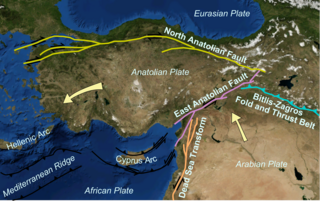 W
WThe 2011 Van earthquakes occurred in eastern Turkey near the city of Van. The first earthquake happened on 23 October at 13:41 local time. The shock had a Mww magnitude of 7.1 and a maximum Mercalli intensity of VIII (Severe). It occurred at a shallow depth, causing heavy shaking across much of eastern Turkey and lighter tremors across neighboring parts of the South Caucasus and Levant. According to Disaster and Emergency Management Presidency on 30 October, the earthquake killed 604 and injured 4,152. At least 11,232 buildings sustained damage in the region, 6,017 of which were found to be uninhabitable. The uninhabitable homes left as much as 8,321 households with an average household population of around 7.6 homeless in the province; this could mean that at least around 60,000 people were left homeless. The other 5,215 have been damaged but are habitable. A separate earthquake within the same earthquake system happened on 9 November at 21:23 local time. 40 people were killed and 260 people were injured in the 9 November earthquake.
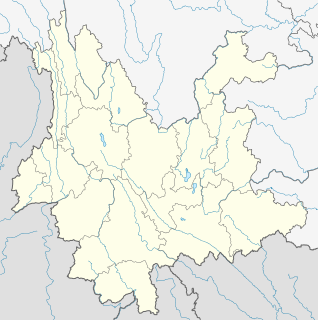 W
WThe 2011 Yunnan earthquake was a 5.4 magnitude earthquake that occurred on 10 March 2011 at 12:58 CST, with its epicenter in Yingjiang County, Yunnan, People's Republic of China, near the Burmese border. A total of 26 people died and 313 were injured with 133 in serious condition. China's Xinhua reports that up to seven aftershocks, measuring up to a magnitude of 4.7, followed the initial quake, which caused a total of 127,000 people to be evacuated to nearby shelters. It joined over 1,000 other minor tremors that affected the region in the two preceding months. Following damage surveys, officials reported that 1,039 buildings were destroyed and 4,994 more were seriously damaged. The earthquake occurred one day before a much larger earthquake struck Japan that also formed a tsunami.